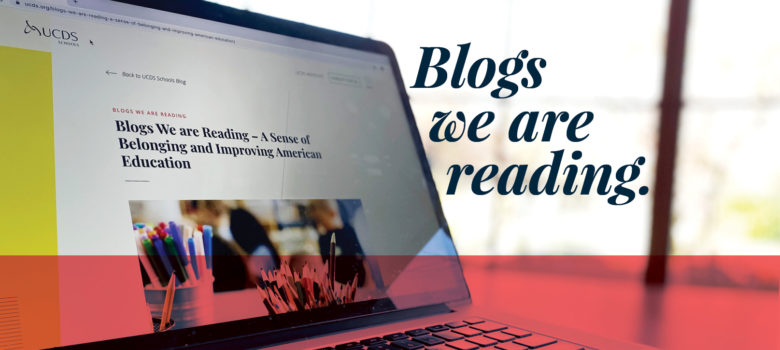By Abby Sandberg, Ph.D. – Learning Specialist and Division Head
This edutopia article outlines best practices when delivering curricula in an online format. After reviewing “Award-Winning Faculty Online Teaching Practices: Elements of Award-Winning Courses” in the Online Learning Journal, edutopia notes that it is inadequate to simply take the material that is presented in the classroom setting and place it online. Instead, curricula must be designed with thoughtful intention to serve students through this particular format. Specifically, edutopia noted that online learning should be authentic and relevant, use a variety of multimedia resources, and that learning should have a clear purpose. Additionally, students should be encouraged to create their own rich content and to reflect on their learning process.
All of these points resonate closely with our process at UCDS during a typical school year on campus. Curricula design has always been a cornerstone of UCDS. Although designing curricula for Distance Learning is a new feat, it has been crucial that we remain anchored by these values that remain quintessential to the UCDS process.
Using an online format, it is perhaps easy to settle into a delivery system of worksheets and practice drills. Designing content that is authentic and relevant, however, is a hallmark of UCDS curricula during a typical school year, and teachers ensured it remained a priority that was not lost during Distance Learning. We truly believe that online learning doesn’t necessarily equate to rote learning. Teachers held steadfast in their goal to design meaningful learning activities that are integrated and relevant to our current lives. Writing skills were practiced through leaving messages of kindness to our community helpers or through hand-written letters to our “buddy” classes. Students practiced data collection and analysis by designing surveys that can be administered to their household members (and beyond!). We carried our school theme, WAVE, throughout the spring as students in all grade levels tracked migrating salmon in our local Pacific Northwest waters.
Teachers embraced the delicate balance of holding live video classes with sharing rich curricula that students can complete at home away from screens and at their own pace. To serve all learning styles, teachers invited students to use a variety of modalities when engaging with content. In addition to teacher-designed printed materials, they also created short videos to explain new concepts, making them accessible for learning at home. For example, teachers demonstrated how to sort toys by different features and then challenged students to do the same and record their results. Teachers held video office hours, welcoming any student to pop in to ask questions to clarify their understanding, or simply listen in while teachers worked with other students, deepening their toolbox of problem-solving approaches. Teachers recorded themselves reading classroom Read Aloud books to serve those students who learn best when they can both see the words and hear them spoken.
Students were invited to share their learning through a variety of methods. Some students made short videos to demonstrate their understanding, while others uploaded photos of their learning process. These creative methods allowed students the freedom to not be constrained to the page, and to fully capture the depth of their knowledge. Of course, while some tasks called for turning in more traditional-looking “assignments,” teachers had the flexibility to individualize to each student if modifications were needed. The goal is that each student was gaining practice and showcasing their understanding in an individualized way that worked best for them. This approach aligns with edutopia’s assertion that students thrive when they can create rich content when engaging with curricula. This approach also primed students to reflect on their learning, another message in this article. Distance Learning challenged every student with a new way to go to school, and this new approach was ripe with opportunities to debrief their process and problem-solve through obstacles. Students gained a deeper understanding of who they are as learners and what they need to be most successful. Distance Learning also encouraged students to practice independence and self-management. UCDS’s approach to student-centered Spring Conferences aligned with the idea that student reflection is an important part of the learning process, especially in this Distance Learning format.
All of these points lead to the final strategy noted by edutopia, “explanation of purpose.” Students appreciate the “why” of academic content. Even through a Distance Learning lens, UCDS strives to design meaningful learning activities through a wide range of modalities that are relevant and within a context. Inviting students to share their understanding in a variety of creative and individualized ways is respectful to different learning styles and propels student investment. This educational approach results in students who are primed to reflect on their process and who they are as learners. While Distance Learning may not have been the school program that families and teachers were expecting, this edutopia article provides solid guidance on how to embrace the process and support student success.




